Our Product Testing Team put these popular brands to the test to settle the GreenPan vs. Caraway debate once and for all
Our editors and experts handpick every product we feature. We may earn a commission from your purchases.Learn more.


Our Product Testing Team put these popular brands to the test to settle the GreenPan vs. Caraway debate once and for all
Our editors and experts handpick every product we feature. We may earn a commission from your purchases.Learn more.
Determining what cookware to buy for your kitchen is stressful. In addition to classic, tried-and-true cookware like a trusty cast-iron skillet, many new brands have been making major waves in the market. Between evaluating a pan’s performance, style and features, there’s also safety to worry about. Nonstick coatings of the past were often made with chemicals that science has since found to be potentially toxic, which is something you never want to hear when you’re talking about food!
With all these choices, how can you determine which is the best? Enter ceramic cookware, made famous by social media-viral brands like Caraway and GreenPan. These brands offer environmentally friendly ceramic alternatives that allow you to continue to use nonstick pans without worry, which is a big part of what makes them appealing. Caraway and GreenPan are also renowned for their aesthetics, making cookware with modern designs in multiple colors.
But with all the similarities, what are the differences that set them apart from each other? We’ve tested both brands as part of a massive ceramic cookware test, and here’s what we can tell you about the GreenPan vs. Caraway debate.
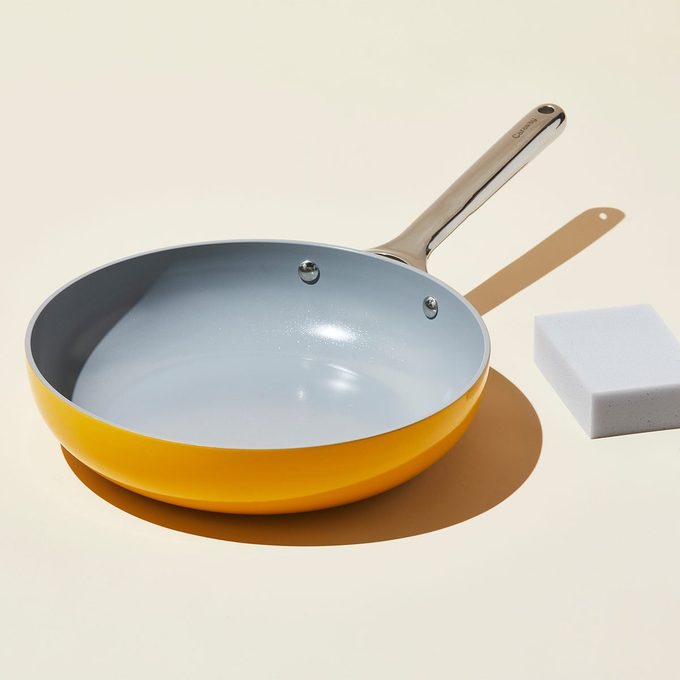
This cookware brand went viral for its nonstick coating and beautiful, vibrant colors. This is one pan you won't want to hide away in a cupboard!
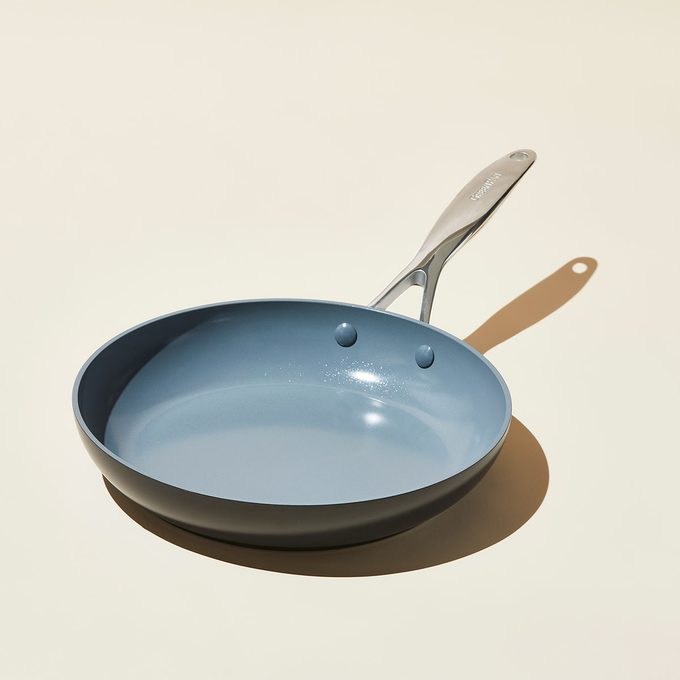
A smooth, slick surface for frying eggs or flipping pancakes? GreenPan's got it—with an affordable price tag, to boot!
We’ve tested a wide range of Caraway products, and each time, we’ve been highly impressed. Not only are they visually stunning, but they also perform exceptionally well in the kitchen. All Caraway products are ethically manufactured by certified partners who ensure safe working conditions and fair compensation. They also ship their products in eco-friendly packaging that’s free of single-use plastics.
GreenPan is built tough with layers of stainless steel topped with its special ceramic nonstick coating. Like Caraway’s ceramic cookware, GreenPan has a nonstick surface that is free from PTFE, PFO and heavy metals. That means you can cook without worrying your food will pick up unwanted chemicals.
According to James Beard award-winning chef Karen Akunowicz, “When shopping for ceramic cookware, look for high-quality, nontoxic coatings that are free of PFAS, PFOA, lead and cadmium. A good ceramic pan should provide excellent heat retention and even cooking.”
Caraway and GreenPan are both known for their internet-famous nonstick ceramic cookware. These pots and pans are designed to be functional, nontoxic and Instagram-worthy. Both offer nontoxic ceramic coatings that don’t leach chemicals into meals. They’re also both designed for low to medium temperatures and offer nonstick properties.
Caraway’s cookware is made of ceramic-coated aluminum, which is oven-safe up to 550 degrees and compatible with all stovetops, including induction. By contrast, GreenPan’s viral cookware features a Thermolon ceramic-based nonstick coating that’s oven-safe up to 600 degrees, but not all the cookware they produce is induction-compatible. GreenPan also offers various products and designs, including a stainless steel cookware line, cutlery, kitchen accessories and small appliances.
The most notable difference between Caraway and GreenPan is that the former is not dishwasher safe, while the latter is. But truthfully, these pans are so easy to clean thanks to their nonstick coating that hand-washing may actually be easier than putting them in the dishwasher!
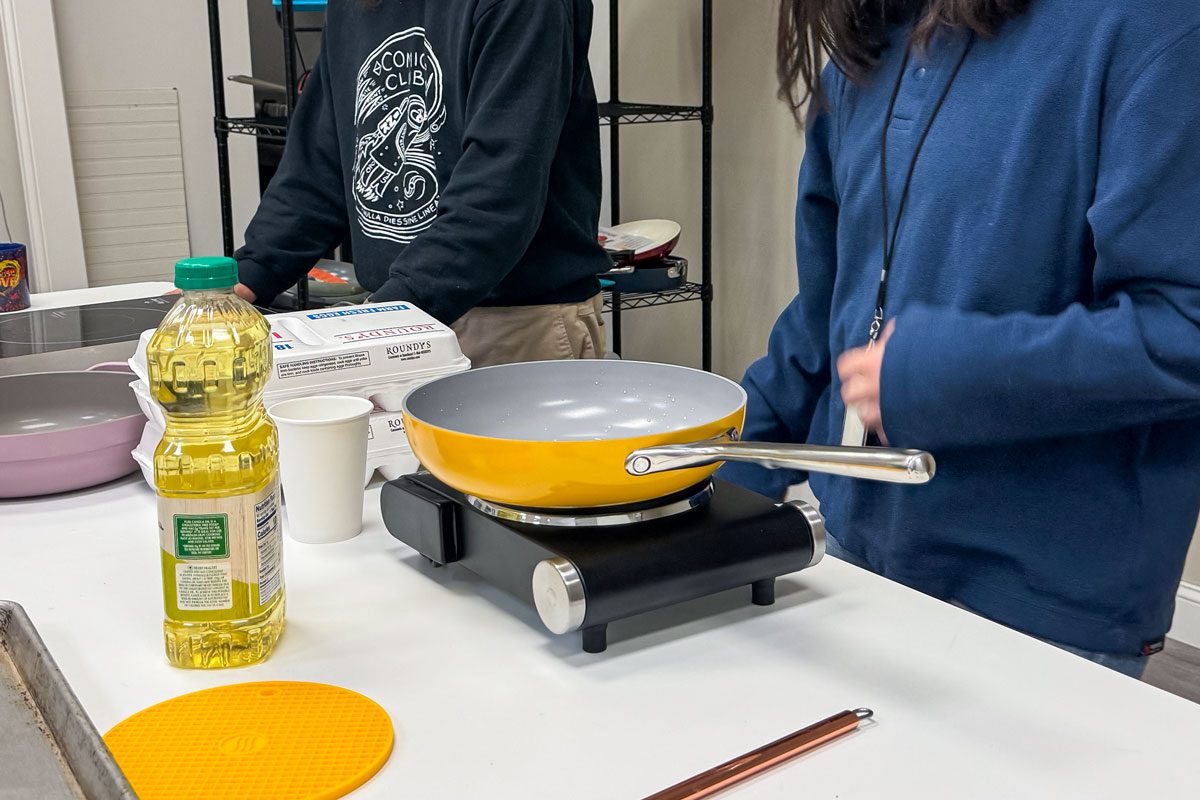
While writing our Caraway cookware review, we were delighted by just how nonstick these pans are. Hardly anything stuck, making cleanup incredibly easy. In our trials, fried eggs effortlessly glided around the pan without any oil! The meats we tested browned beautifully, although we observed some uneven heating, with the center of the pan becoming hotter than the edges.
One of our editors who uses Caraway at home had to replace her frying pan after three years of daily use when the nonstick ceramic coating began to chip away from the aluminum core. However, she attributed this to her frequent use of metal utensils and harsh scrubbers, which the manufacturer says to avoid. But she continues to enjoy cooking with her replacement pan, now using nonstick-safe silicone tools.
One of our editors was also impressed with the Caraway prep set, while another swears by her Caraway bakeware set.
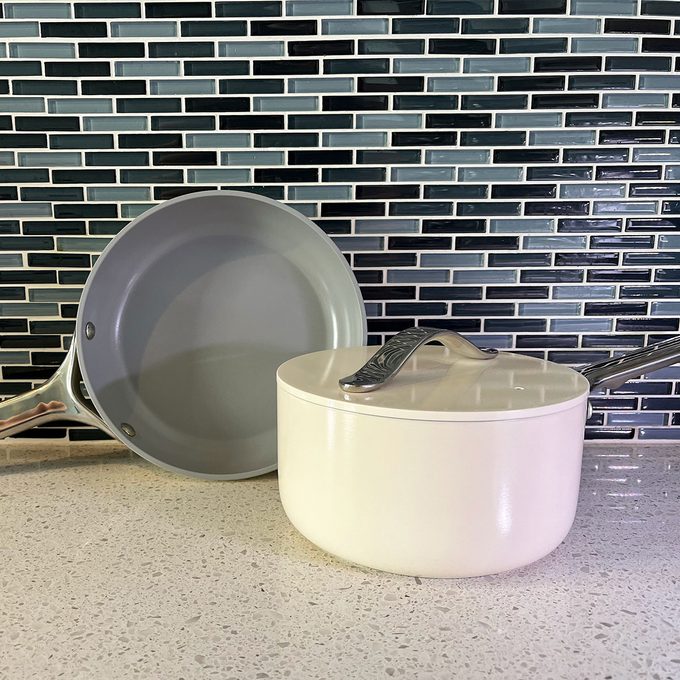


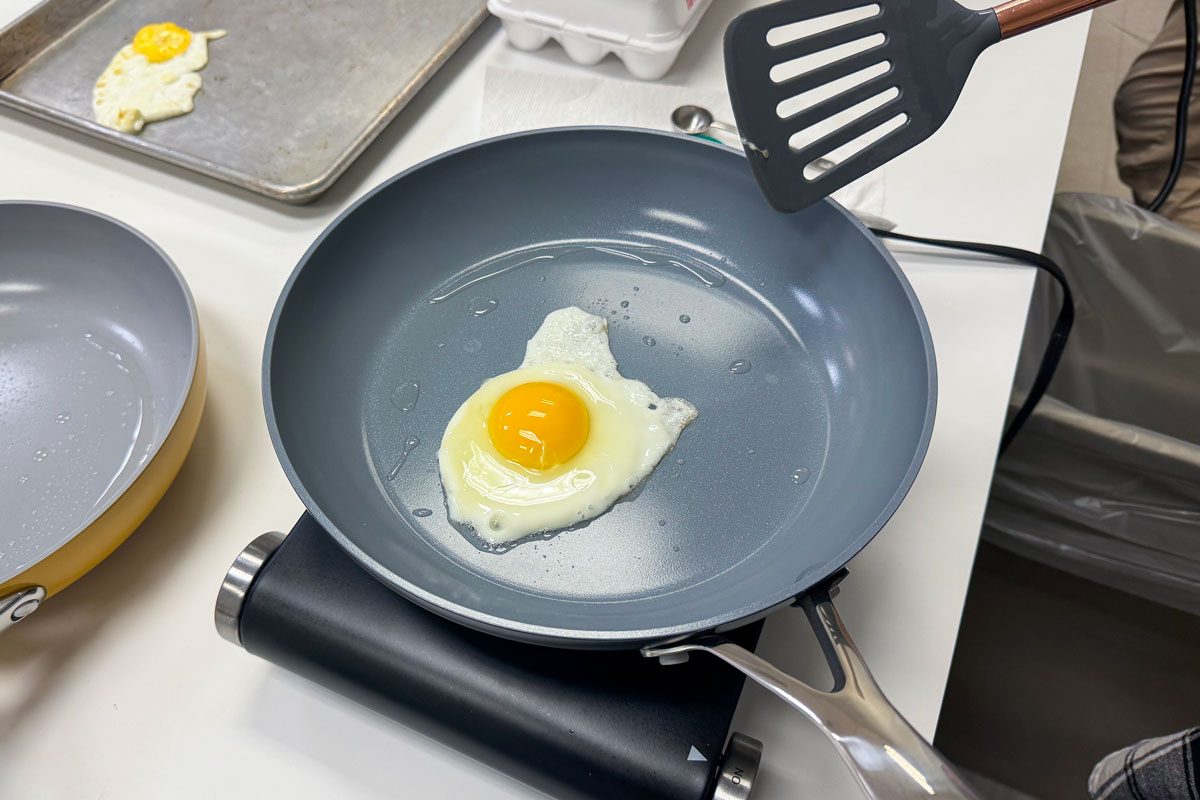
When we brought the GreenPan frying pan into our Product Testing Lab, it blew us away. Nothing stuck! Chicken tenderloins browned gorgeously; eggs slid around the pan without needing a drop of oil. We love that these pans are dishwasher safe, but honestly, you don’t need an appliance for cleanup. They’re so nonstick that hand washing them takes only a few seconds. For more details, read our full GreenPan review.
GreenPan also offers a slew of other eco-friendly products. In addition to the famous frying pan, there are also full ceramic cookware sets, stainless steel pans, cast-iron pieces like Dutch ovens and many more. They also produce a line of bakeware and cutlery, as well as a wide range of small appliances like waffle makers and slow cookers.
GreenPan releases new collections all the time, so in 2025 we revisited this piece to test a few newer products. Content Director Nicole Doster tried a range of new releases, including GreenPan’s Spectra cookware, GreenPan’s Reserve bakeware and their lineup of Platinum silicone tools.
The brand’s Spectra cookware combines the best worlds of ceramic nonstick and stainless steel. It’s definitely a competitor’s answer to popular new hybrid cookware like our editor-approved HexClad cookware. Nicole raves about its delightful nonstick properties, noting that eggs, meats and even melted cheese did not stick to the pan.
“The pan heats up very quickly which is a perk for impatient cooks like myself. Additionally, it seared foods well. Not as well as my trusty cast-iron, but better than other nonstick pans I’ve used in the past,” she says.
As for the Reserve bakeware, Nicole was also a fan. “Overall, the bakeware is nice—I think the best thing about it is its appearance,” she says. “The golden handles elevate the bakeware from a cooking vessel to serveware I’d be happy to show off at dinner parties. The bakeware is also very easy to clean—mostly because food didn’t stick to it. I was impressed that the kit also came with pan protectors, to prevent dings/scratches when storing.” Nicole does note that they are a bit on the heavy side, which isn’t ideal for those with accessibility issues.
One of Nicole’s favorite sets, though, are the Platinum silicone tools. “I am a big fan of using silicone tools in the kitchen, but I am very picky,” she says. “They can’t be too flimsy—or else they don’t work well/risk tearing. I also have seen the horrors of what using metal tools on nonstick cookware can do (think: terrible scratches and cookware that’s ruined forever).”
Overall, she finds the tools stiff enough to be effective, thanks to their stainless steel core. In particular, Nicole raves about the thin tips of both turners, which make it easy to lift food from the pan. Another notable perk she mentions is that these tools don’t have any seams or ridges for food to get stuck into, so they are very easy to clean.

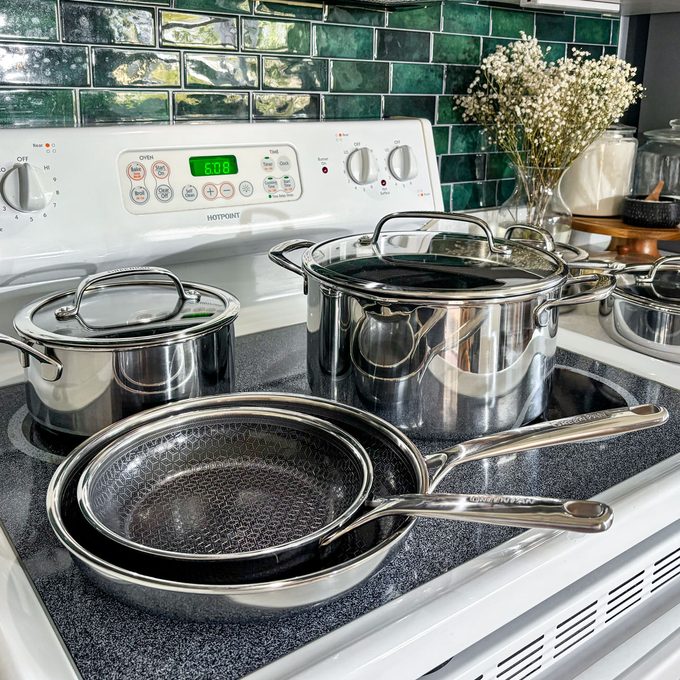
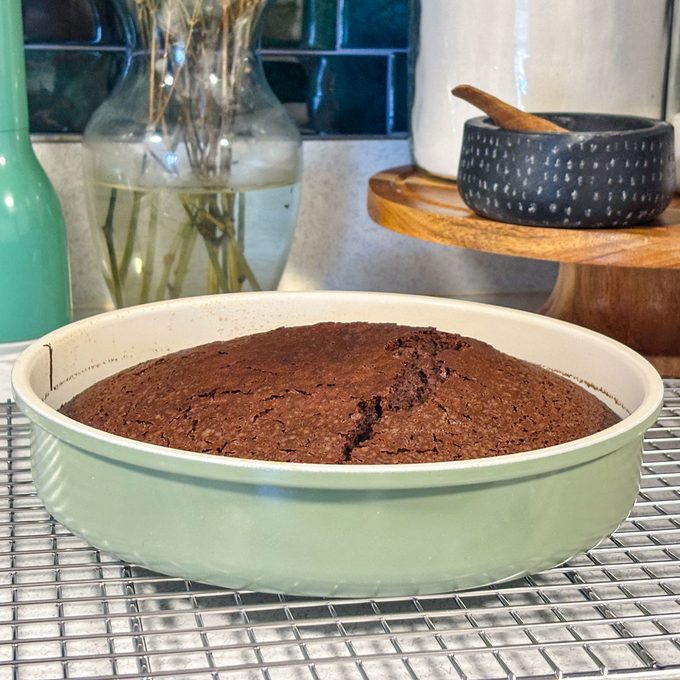
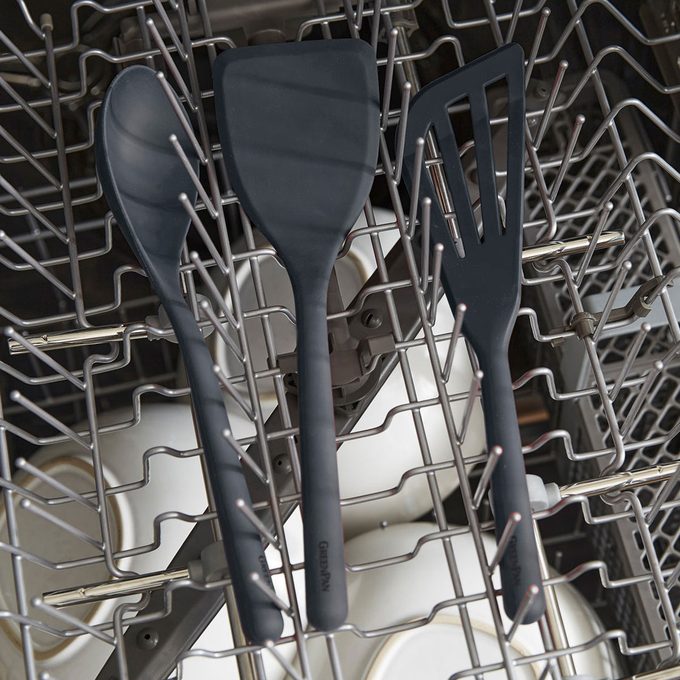
When considering GreenPan vs. Caraway, the first thing to consider is your budget. Caraway is pricier than GreenPan, but their products have consistently been top performers in our tests and have continued to deliver top-quality performance after years of use. Alternately, GreenPan is more affordable, but the nonstick coating has suffered more over time. If you don’t cook a lot and are on a tighter budget, it might be your better choice.
The best place to buy Caraway cookware is directly through their website. The company frequently runs sales and discounts on items, so if you keep your eyes open, you can score some great deals. Though you can find GreenPan cookware through many major retailers, the only place to find everything the company offers is through the GreenPan website. Happy cooking!
According to our tests, Caraway stays nonstick longer, but GreenPan is less pricey and performs just as well, at least while the nonstick ceramic lasts.
Both GreenPan and Caraway use a ceramic coating instead of traditional nonstick, making them both nontoxic choices. Worth noting, the term “non-toxic” means different things in different contexts, and is more of a marketing term than anything with true regulations around it. Ceramic pans can still be toxic if you nick the coating and expose the metals beneath it; be sure to use nonstick-friendly utensils like wood or composite, not steel.
Yes! Most ceramic cookware like GreenPan and Caraway can go into the oven. Check the owner’s manual for details specific to your cookware.
GreenPan is a good Caraway alternative, as are other ceramic cookware options. We’ve tested 19 ceramic cookware brands, and our favorites, based on extensive comparative testing, include: Caraway, GreenPan, Xtrema, Beautiful by Drew, Alva, Our Place, Sur la Table, OXO and GreenLife.
“Eco-friendly” has different meanings depending on who you ask. In the context of cookware, it typically means free from “forever chemicals,” a.k.a. PFAS, which include PTFE, PFOA and PFOS. These chemicals have been found to leech into our water supply and contaminate it, causing harm to humans, flora and fauna all over the world. Ceramic cookware is considered more eco-friendly than Teflon-coated options, but the truth is, most ceramic cookware requires a bonding agent to get the ceramic to stick to the metal part of the pan. Those bonding agents often contain some form of PFAS. The most eco-friendly cookware remains cast iron and stainless steel.
Our Product Testing Team put over a dozen ceramic pans to the test. We collected about 675 data points and performed roughly eight tests on each pan. For performance, we cooked up a chicken tenderloin, flipped over-easy eggs and whipped up a crêpe on each pan. Primary product tester Sheri Kaz has reviewed dozens of home and lifestyle products for Family Handyman, Reader’s Digest and Taste of Home. She has firsthand experience trying out numerous kitchen gadgets and tools, making her a reliable source of information when picking the best ceramic cookware.
As for me, I’m a shopping editor at Reader’s Digest, Family Handyman and Taste of Home as well as a former sales and deals editor. In these roles, I found, reviewed and tested hundreds of products ranging from outdoor gear, food and recipes, travel gadgets and tools.
For this piece, I also spoke to Karen Akunowicz to discuss what to look for when choosing ceramic cookware. Karen is a James Beard award-winning chef, restauranteur, and television personality who has made appearances on Bravo’s Top Chef and Food Network’s Tournament of Champions.